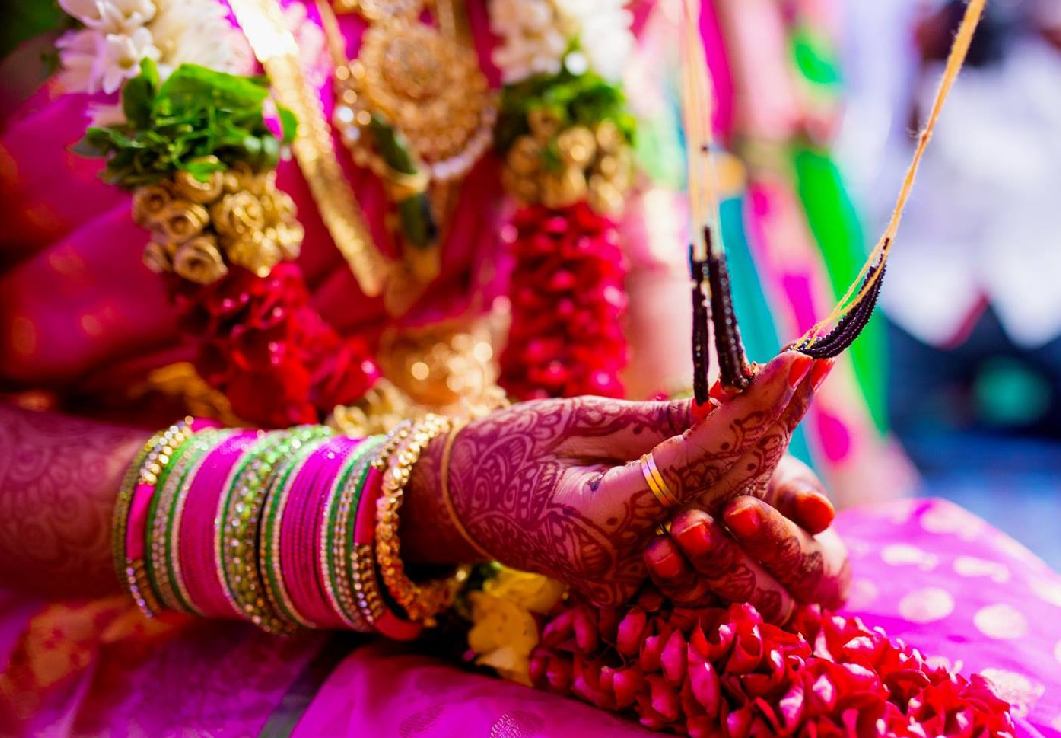
Traditional Telugu Wedding Rituals: All You Need to Know
 Oct 22, 2020
Oct 22, 2020There are five states in Southern India, and all the states have their own unique rituals when it comes to Weddings. The two Telugu-speaking Indian states are Telangana and Andhra Pradesh. Even though some traditions are region-specific, most of the rituals explained in this blog are shared between both the states. All the ceremonies prior and post the wedding are as important as the Muhurtham Day. For this reason, a Traditional Hindu Wedding can go on for 3 to 5 days. But it also depends on how elaborately the families choose to celebrate each ritual. In order to help you understand the importance of each of these functions, we have described each of these Telugu Wedding Rituals for you.
Pre- Telugu Wedding Rituals
1. Nischithardham
This is similar to the ‘Roka’ or ‘Sagai’ ceremonies in the northern states. In the presence of family and close friends, the family of the bride and groom finalize their engagement. The parents exchange sweets, jewelry, clothes, and other auspicious items to symbolize their exchange of love. This day, the families officially accept each other; and the bride and the groom get engaged to be married.
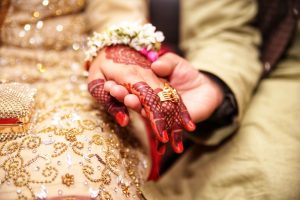
2. Pellikuturu/ Pellikodukuni Cheyuta
This is a day full of different ceremonies. It is equivalent to North-Indian ceremonies of Haldi, Mehendi and Sangeet. Each of the rituals subsequently cleanse the body, mind and spirit of the bride and the groom to ready them for the next phase of their life.
3. Nalugu
Early in the morning, at a set auspicious time, this ceremony takes place in the respective houses. Nalugu (a mix of turmeric powder, chanaga pindi/besan, and water/ essential oils) is smeared on the bride and the groom. All the close family members and friends participate and apply the nalugu on the face, shoulders, knees and feet of the bride/groom with tamalapaku/betal leaves.
4. Magala Snanam/ Mangala Harathi
This follows a turmeric water shower on the bride/groom. This is done to cleanse the body of the bride and the groom. After the Magala Snanam, The elders advise the bride and groom not to step outside the house for anything, except going to the mandapam (the venue of the wedding). After the Mangala Snanam, follows the Magala Harathi. The elders of the house give harathi to the bride and groom (in their respective houses) to rid them of any evil eye. This celebration concludes by noon.
5. Mehendi/ Sangeet
In the late afternoon, Gorintaku/ Mehendi is applied on the hands and legs of the bride/groom. Scientifically, mehendi releases body heat and helps in regulating the body temperature. As the wedding week is full of mixed feelings, mehendi plays its role in helping the bride and groom stay calm. Sangeet is celebrated simultaneously, or on the next day. All the family members sing and dance to express their happiness and to celebrate the holy union.
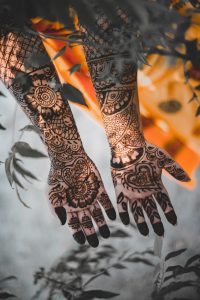
6. Gowri Pooja/ Pradanam
This is a ritual performed only by the bride, on the evening before the wedding day. The bride offers her prayers to Goddess Gowri, who is the symbol of fertility and motherhood. Following the Gowri pooja, the groom’s mother and sister gift the bride with jewelry and Muhurtham saree.
The Telugu Wedding Rituals
1. Ganapathy Pooja
The groom enters the Mandapam/venue before the bride. The bride’s brothers and maternal uncles receive the groom at the entrance lead him towards the stage. The groom then performs the Ganapathi Pooja on the stage. According to Hindu tradition, Lord Ganesha receives the Prathama Vandana/ the first salutations. He is the Vignaharta/ remover of obstacles. Thus, on the day of the wedding, the very first ritual is to invoke Lord Ganesha’s blessings.
After the Ganapathy Pooja, the bride enters the venue accompanied by her family. As her parents lead her towards the stage, her maternal uncles hold a cloth between her and the groom. This is called the Terasala (‘tera’=screen). Until the muhurtham time, the bride and the groom are not to see each.
2. Kanyadanam and Panigrahanam
Kanyadanam is the ritual wherein the parents of the bride officially give away their daughter to the groom. With the terasala still between them, the parents of the bride wash the groom’s feet. This ritual is a symbolic. The groom symbolizes Lord Vishu who will soon marry the bride who symbolizes the Goddess Laxmi. After this, the bride’s parents place the bride’s hands in the groom’s hand. This ceremony is called the Panigrahanam. By taking the bride’s hands into his own, the groom promises the bride and her family to be by her side through the ebbs and flow of life.
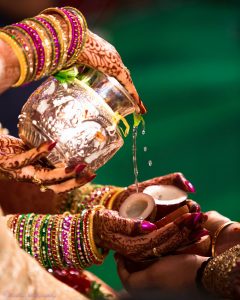
3. Jeelakara Bellam
This is the most important ritual of the wedding. On the sumuhutham (the auspicious wedding time), the bride and the groom apply a paste of jeelakaram bellam (a paste made of pounded cumin and jaggery). The significance of this ritual is to promise each other to be inseparable in body, mind and soul, just as the pounded cumin and jaggery. Amids the loud chants of Vedam and ‘sannai mellam’ (shehnai), the bride and the groom press this a paste on top of each other’s head, and simultaneously the Terasala is removed. The elders and other family and friends sprinkle akshantalu (turmeric rice) over the bride and the groom.
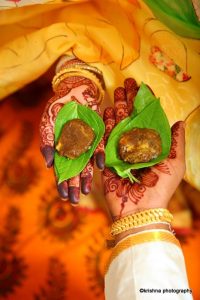
4. Mangalasutram Dharana
Immediately after the Jeelakara Bellam, the bride and the groom are asked to change into the madhuparakam. This is the white/cream colored attire with red/green/yellow border. While the bride and the groom get ready in their respective rooms, the pandit places the mangalasutram on a coconut and passes it amongst the family members for blessings. When they bride and the groom return, the groom ties the mangalasutram or thaali (a sacred yellow thread smeared with turmeric with 2 gold pendants at the middle called Sutralu). The groom ties three knots, each representing Manasa (thoughts), Vacha (speech), and Karmana (action). This particular ritual also signifies the union of the two souls physically, mentally and spiritually. The yellow thread is replaced with a gold chain on the 16th day after the wedding.
5. Talambralu
This is like a fun break between two main events. For this ritual, the bride and the groom shower each other with turmeric rice. The first 3 times are significant, after which it turns into a game. The families too get involved and try that help their person win pour more rice over the other.
6. Dandalu
After the talambralu, the bride and the groom exchange flower garlands expressing their acceptance of the other as their life patner.
7. Metalu and Nalla Pusalu
At this moment, the maternal uncle of the bride adorns her second toe of both the legs with Metalu/ silver toe ring. In some traditions, the groom does this instead of the uncle. After the metalu, the groom adorns his bride with nalla pusalu/ a necklace made of black and gold beads. These nalla pusalu are to avert evil eye.
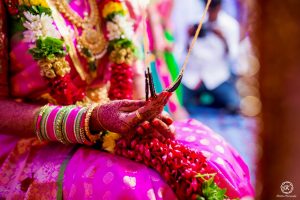
8. Saptapadi
This is synonymous to the Saath Phere in the traditions of the northern states. Each of the seven steps have a distinct meaning. These seven steps are walks around the homam/ holy fire. The first 3 rounds are lead by the groom and the next four by the bride. As they walk these seven steps, they promise each other nourishment, togetherness in both joy and sorrow, wealth, strength, to care for their parents, to care for their children, to remain friends forever.
9. The Ring Game
This is yet another ice breaker, not just for the couple but for the families as well. For this game, a gold ring is dropped into a pot, full of turmeric water. The bride and the groom put their right arms to find the ring. The first one to find the ring two out three times wins. To make it interesting, you can also put one gold and silver ring, and the game is the person who finds the gold ring twice wins. The game is healthy competition which also depicts who will have a upper hand in the marriage, the bride or the groom.
10. Arundhati Nakshtram
After this friendly game, the pandit takes the couple out of the mandapam. Here the groom points at the Arundhati Nakshatram. Arundhati Vasistha represent an ideal couple, and by pointing at this star, the groom promises the bride an ideal life.
11. Appagintalu
The final ceremony of the wedding day, is when the bride officially leaves her maternal home with her husband. This is an emotional time for the girl’s family.
Post- Telugu Wedding Rituals
1. Gruhapravesham
The bride officially enters her new home for the first time. This is considered very important, as this marks a new beginning for the couple. A vessel of rice is placed at the door. After giving harathi to the couple, the mother-in-law asks the bride to gently push the vessel with her right leg. The scattered rice symbolizes the prosperity which the bride brings with her.
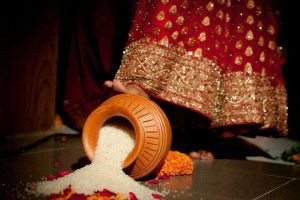
2. Satyanarayana Pooja
The next morning, a Satyanarayana Pooja is held at the groom’s place. ‘Satya’ means ‘truth’ and Satyanarayana, is considered the highest form of eternal truth. This pooja is conducted to invoke Lord Satyanarayana to bless the couple at the beginning of their new journey. On this auspicious note, traditional Telugu Wedding Rituals conclude.
Curious about other Indian Wedding Rituals. Click here to know about Maharashtrian Wedding Rituals and Parsi Weddings Rituals.
Loading data...














